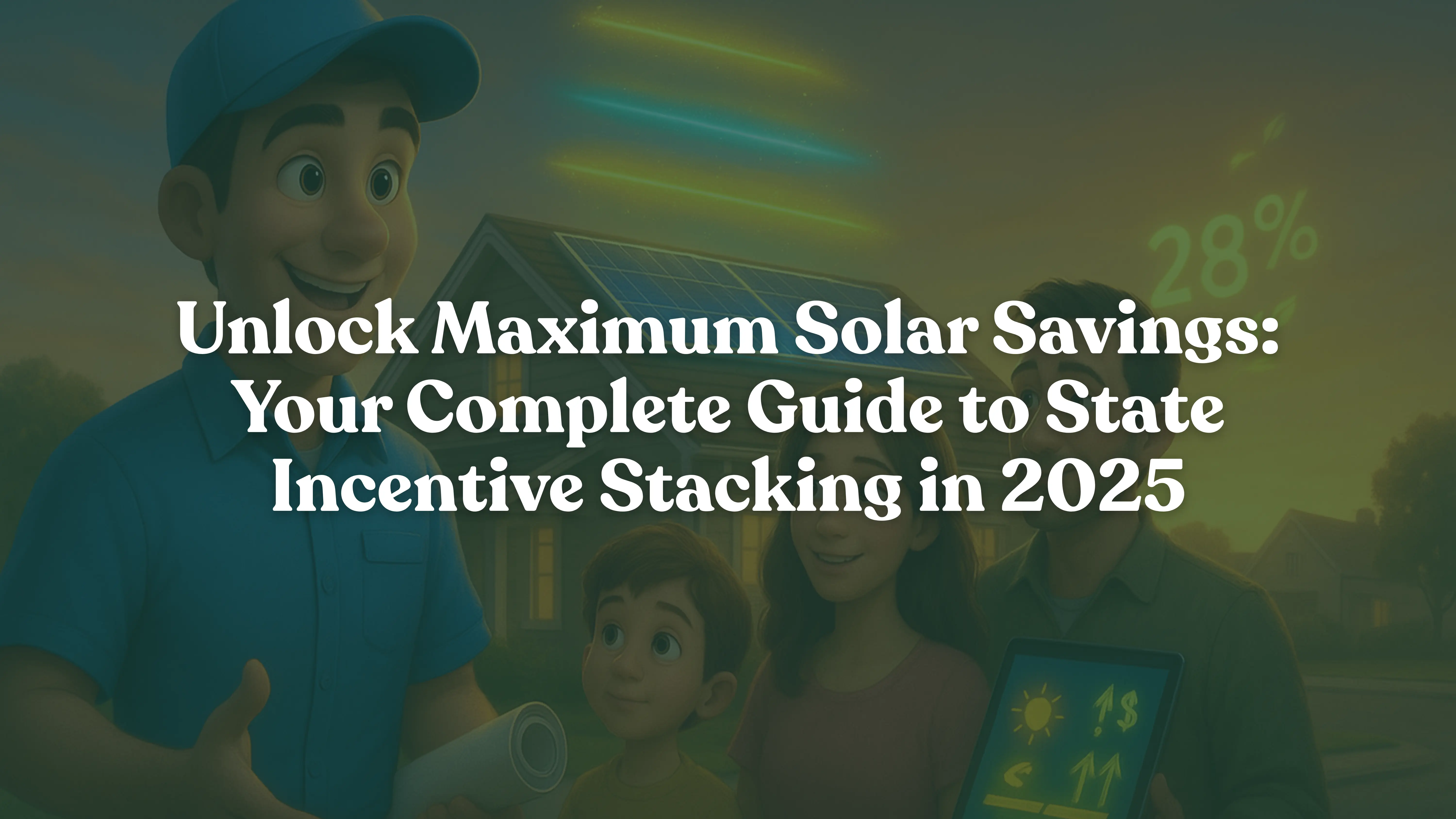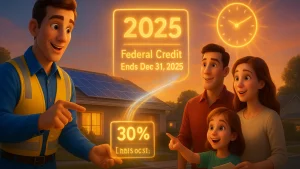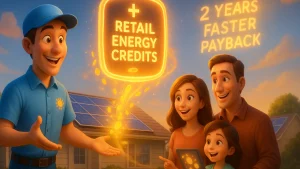Solar Incentive Stacking Strategies: 2025 Guide

Solar Incentive Stacking Strategies: How to Maximize Customer Savings Beyond the Federal Tax Credit in 2025
Quick Answer Box
Looking to maximize your customers’ solar savings? Solar incentive stacking strategies combine federal tax credits (30%), state rebates, SRECs, and local programs to reduce installation costs by 50-60%. With the federal residential credit ending December 31, 2025, mastering these solar incentive stacking strategies is critical for installers and EPCs to stay competitive.
The clock’s ticking on solar savings. Your customers are asking: “How much can I really save?” As solar installers and EPCs, you already know the answer goes far beyond that 30% federal credit. The real value comes from implementing smart solar incentive stacking strategies.

In fact, when you properly combine incentives, customers can slash project costs by 50% or more. However, with residential solar tax credits ending December 31, 2025, the window for maximum savings is closing fast. That’s why understanding solar incentive stacking strategies isn’t just helpful—it’s essential for your business survival.
Let’s dive into exactly how to turn incentive stacking into your competitive advantage.
What Is Solar Incentive Stacking and Why Does It Matter?
Solar incentive stacking strategies involve combining multiple financial benefits from different sources. Rather than relying solely on one program, you’re layering federal, state, and local incentives together.
Think of it like building a financial sandwich. Each layer adds value. The federal tax credit provides the foundation. State programs add the next layer. Local utility rebates and property tax exemptions complete the stack.
Moreover, most customers don’t realize these programs work together. They assume choosing one means giving up another. Your job is showing them the full picture. When you do this well, you’re not just selling solar—you’re delivering financial transformation.
According to the Solar Energy Industries Association (SEIA), the industry has grown 28% annually over the past decade. Much of this growth stems from installers who master incentive stacking.
Understanding the Federal Solar Tax Credit Foundation
The federal Investment Tax Credit (ITC) remains the cornerstone of solar savings. Currently, it offers 30% back on total system costs through 2025. For instance, a typical $20,000 installation means $6,000 in direct tax savings.
However, recent policy changes have created urgency. The “One Big Beautiful Bill” signed in 2025 means residential systems must be installed and operational by December 31, 2025, to qualify. After that date, homeowner-owned systems lose access to this valuable credit entirely.

Third-party owned systems get a grace period through 2027. Nevertheless, for direct ownership projects, the deadline is firm. This makes 2025 the critical year for implementing solar incentive stacking strategies.
Additionally, the federal credit applies to the full system cost before other rebates. This positioning maximizes its value within your stacking strategy. For detailed federal tax credit information, visit the Database of State Incentives for Renewables & Efficiency (DSIRE).
Which State Solar Incentive Programs Offer the Best Stacking Opportunities?
State-level programs provide the biggest differentiator in competitive markets. Furthermore, these incentives often surprise customers with their value. Let’s explore the top opportunities.
Solar Renewable Energy Certificates (SRECs)
SRECs create ongoing value streams that customers love. Ten states plus Washington D.C. maintain active SREC markets. These programs pay customers for the clean energy their systems produce.
New Jersey’s Successor Solar Incentive (SuSI) program leads nationally. Average residential systems earn between $10,000 and $12,000 over 15 years. Meanwhile, Maryland homeowners pocket over $400 annually at current SREC rates.
Importantly, SRECs stack perfectly with federal credits because they represent different value sources. The federal credit reduces upfront costs. SRECs provide ongoing income. Together, they create compelling financial stories.
Performance-Based Incentives That Keep Paying
Performance-based incentives differ from one-time rebates. Instead, they pay customers for every kilowatt-hour their system generates. Illinois and New York lead this category.
For example, New York’s expanded storage incentives now include performance payments. This creates additional revenue streams beyond energy savings alone. When you present these in proposals, customers see both immediate and long-term value.
State Tax Credits You Can Stack
Seven states offer state tax credits including Arizona, Massachusetts, and South Carolina. These stack directly with federal credits because they apply to different tax obligations.
Consider a Massachusetts customer. They claim the 30% federal credit ($6,000 on a $20,000 system). Then they add the state credit up to $1,000. That’s $7,000 in combined tax benefits—pure additional savings from effective solar incentive stacking strategies.
How to Implement Solar Incentive Stacking Strategies Step-by-Step
Successful incentive stacking follows a specific sequence. First, calculate the federal ITC based on full system cost. This provides your foundation amount.
Next, layer state tax credits. These typically don’t reduce your federal credit basis, so customers get full value from both. Third, add state rebates and utility programs. Minnesota utilities, for instance, offer upfront rebates that combine with federal incentives to cover 40%+ of costs.

Finally, include property tax exemptions. Over 30 states exclude solar systems from property value assessments. While this doesn’t provide upfront cash, it prevents annual tax increases that could cost thousands over time.
Here’s a practical example:
- System cost: $20,000
- Federal ITC (30%): -$6,000
- State rebate: -$2,000
- Utility incentive: -$1,500
- 15-year SREC value: -$10,000
- Total savings: $19,500 (98% of system cost)
This demonstrates why solar incentive stacking strategies matter so much.
What Are Regional Variations in Incentive Stacking?
Different states require different approaches. Therefore, understanding regional nuances helps you craft stronger proposals.
California’s Post-NEM 3.0 Landscape
California customers face reduced export compensation under NEM 3.0. Consequently, you’ll emphasize self-consumption and battery storage more. However, California’s property tax exclusion becomes more valuable as a selling point when other incentives decline.
Additionally, local programs vary significantly by utility. San Francisco offers different incentives than San Diego. Your solar incentive stacking strategies must account for these differences.
New York’s Multiple Stacking Paradise
New York continues to shine with abundant opportunities. The NY-Sun program provides direct incentives based on system size and location. Combined with state tax credits and robust SREC markets, customers reduce costs by up to 60%.
Moreover, New York recently expanded battery storage incentives. This creates additional stacking possibilities beyond traditional solar-only systems.
Texas’s Utility-Focused Approach
Texas presents unique challenges with limited state programs. However, savvy installers leverage utility-specific rebates effectively. Some utilities offer rebates exceeding $2,500.
Furthermore, Texas property tax exemptions add significant value. When you highlight these local opportunities, you compete effectively even without state-level programs.
Why Net Metering Amplifies Your Incentive Stack
Net metering isn’t technically an incentive. However, it multiplies every dollar your customer saves. States with strong net metering policies let customers bank credits at retail rates.
When calculating payback periods, full retail net metering shortens them by 2-3 years compared to reduced compensation states. This makes your proposals more attractive even with identical incentive packages.

Nevertheless, the policy landscape is shifting. Seven states modified net metering rules in the past 18 months. Stay current on local policies and adjust proposals accordingly. Customers who understand these nuances trust your expertise more.
For current net metering policies nationwide, check SEIA’s state policy database.
How Can Installers Implement These Strategies Successfully?
Taking action on solar incentive stacking strategies requires practical systems. Here’s how top-performing installers approach it.
Create State-Specific Proposal Templates
First, build templates that automatically calculate all available incentives. Customers comparing quotes often miss stacking potential. Your detailed breakdown becomes your competitive edge.
Include sections for:
- Federal ITC calculation
- State tax credits
- Local utility rebates
- SREC projections
- Property tax exemption value
- Net metering benefits
Build Strategic Relationships
Additionally, develop relationships with state energy offices and utility program managers. You’ll get advance notice of program changes. This insider knowledge positions you as the expert delivering maximum value.
For example, when New Jersey transitioned from TREC to SuSI programs, connected installers helped customers navigate changes smoothly. Those relationships became referral engines.
Document Everything Meticulously
Furthermore, maintain thorough documentation. IRS audits happen, and state programs have specific requirements. Customers who sail through claiming incentives become your best referrals.
Create checklists for each incentive type. Track submission deadlines. Follow up to ensure customers complete applications. This hand-holding differentiates professional installers from competitors.
What Local and Municipal Incentives Should You Include?
Don’t overlook municipal and county programs. These smaller incentives often provide the margin that makes projects feasible.
Cleveland and Cincinnati, for instance, offer property tax exemptions beyond state incentives. Some counties provide low-interest financing. While not direct rebates, this reduces customers’ cost of capital significantly.
Community solar programs are expanding rapidly. Illinois and New York lead this growth. Even if customers can’t install rooftop panels, position yourself as the guide to community solar benefits. These relationships often convert to future rooftop projects.
Search for local programs through your city or county energy office. Many maintain databases of available incentives.
When Should Customers Act on These Incentives?
Timing is critical for effective solar incentive stacking strategies. With the residential federal credit sunset approaching, educate customers about safe harbor provisions.
Systems starting construction before December 31, 2025, may qualify even if installation stretches into early 2026. However, documentation requirements are strict. Know them thoroughly.
Moreover, state program funding often works first-come, first-served. New Jersey’s SuSI program and Massachusetts’ SMART incentive both have capacity limits. Customers who wait might miss out entirely.
Your urgency messaging should be honest but clear about real deadlines. Don’t create false scarcity. Instead, present factual deadline information and let customers decide.
How Do You Make Solar Incentive Stacking Strategies Your Differentiator?
Training your sales team properly makes all the difference. Teach them to explain stacking in simple terms.
For example: “You’re getting 30% federal credit, $2,000 state rebate, $8,000 in SRECs over time, and property tax exemption. Together, that’s not just savings—it’s financial transformation.”
Create comparison tools showing scenarios with and without full incentive stacking. The difference often means projects paying for themselves 5+ years faster. That’s a compelling story that closes deals.
Additionally, follow up post-installation. Help customers claim every incentive. Your hand-holding through federal tax credits, state rebate applications, and SREC registration creates raving fans.
Stack Smart — Energyscape Renewables Makes It Simple
Incentive stacking can cut customer costs by 50–60%, but only if every credit, rebate, and SREC is captured with precise documentation and timing.
Energyscape Renewables provides the engineering backbone installers need — permit-ready plansets, fast PE stamping, interconnection support and storage-ready designs — so you can reliably present full-stack savings and close more deals.
Paired with Sunscape (Site Survey App + CRM) to automate surveys, proposals and workflows, your team avoids manual errors, speeds approvals, and helps customers claim every available dollar.
Short and actionable: sell total savings, not just panel prices — Energyscape + Sunscape handle the engineering, permitting, and execution so you capture the full value for your customers.
Frequently Asked Questions About Solar Incentive Stacking
What is solar incentive stacking?
Solar incentive stacking combines multiple federal, state, and local solar incentives to maximize customer savings beyond the 30% federal tax credit. This strategy layers different programs together rather than choosing just one.
Can you combine federal and state solar tax credits?
Yes, federal and state solar tax credits can be stacked because they apply to different tax obligations. The federal credit applies to federal income taxes while state credits apply to state income taxes.
Which states have the best solar incentive programs?
New York, New Jersey, Massachusetts, California, and Illinois offer the most comprehensive stacking opportunities. These states combine SREC programs, state rebates, tax credits, and strong net metering policies.
When does the federal solar tax credit end?
The 30% residential federal solar tax credit ends December 31, 2025, for homeowner-owned systems. Third-party owned systems can still qualify through 2027 under different provisions.
How much can customers save through incentive stacking?
Customers in states with robust programs can reduce total solar costs by 50-60% when properly stacking federal, state, and local incentives. Some exceptional cases achieve even higher savings rates.
Do property tax exemptions count as incentives?
While property tax exemptions don’t provide upfront cash, they prevent annual tax increases as your home value rises. Over 20-25 years, this saves customers thousands of dollars in avoided taxes.
How do SRECs work with other incentives?
SRECs generate ongoing income based on system production. They stack perfectly with upfront incentives like federal tax credits and state rebates because they represent different value streams.
What happens if customers miss the federal tax credit deadline?
Systems not installed by December 31, 2025, lose access to the residential federal tax credit. However, state and local incentives typically remain available. Focus shifts to these remaining programs.

sjayakanth@energyscaperenewables.com